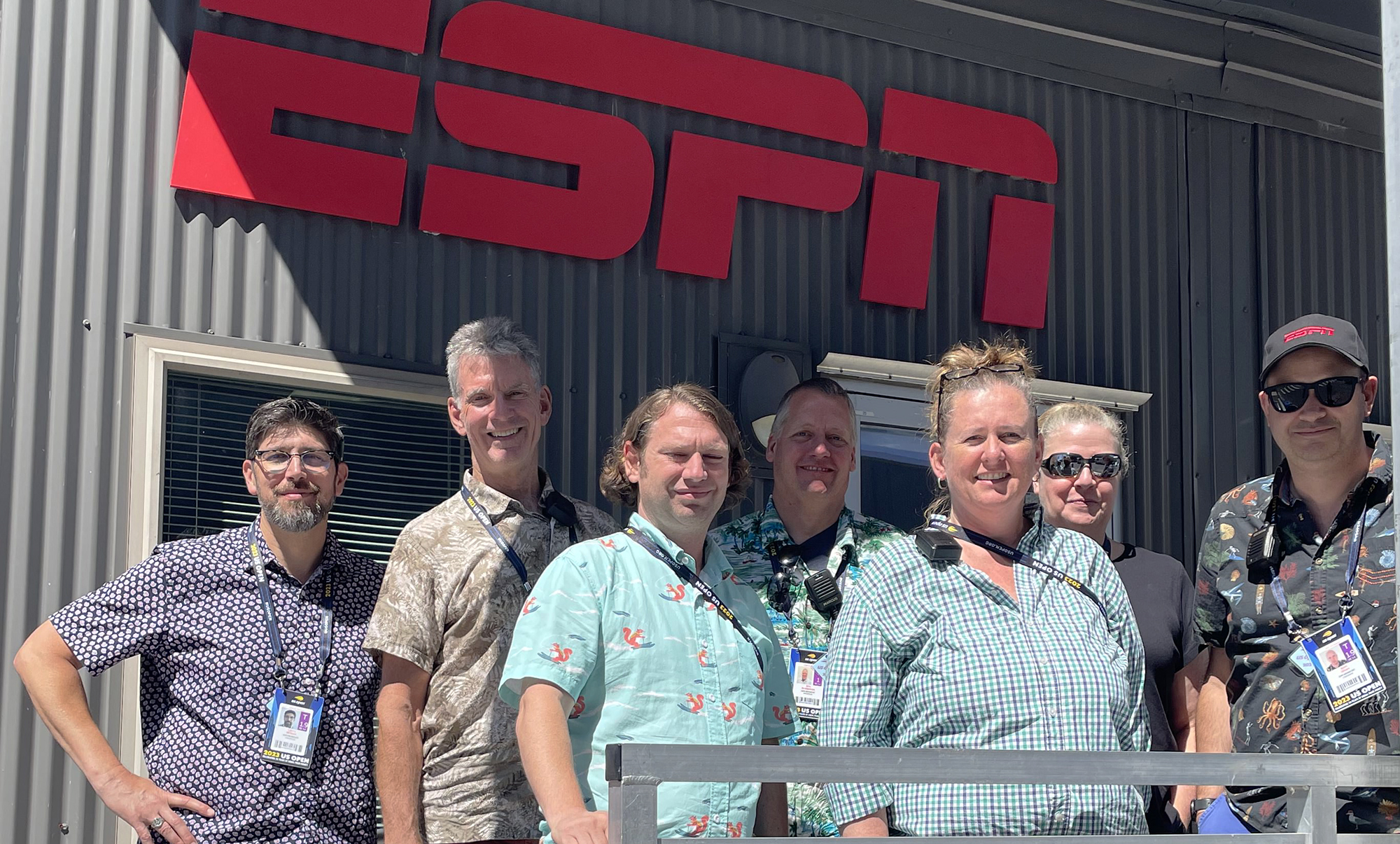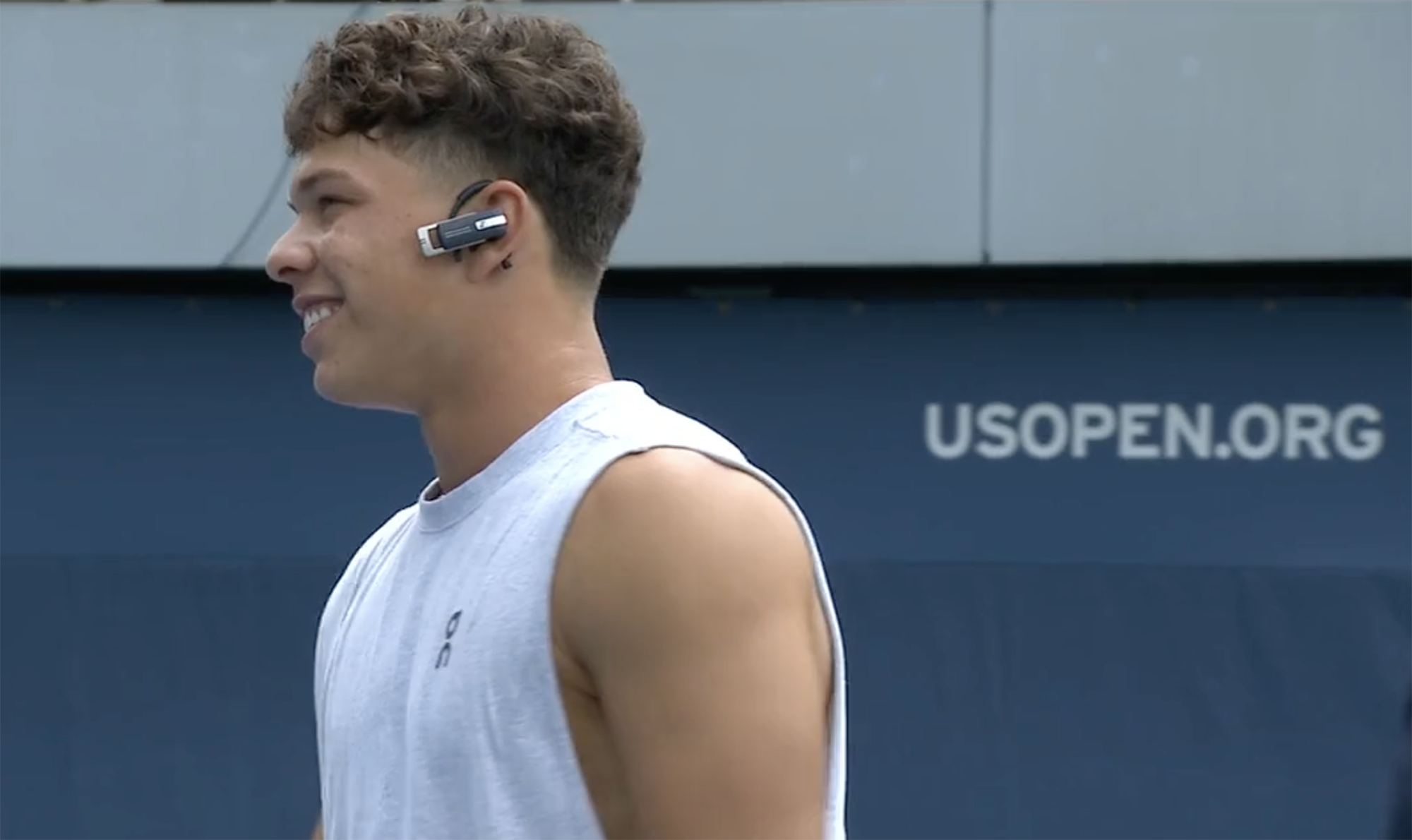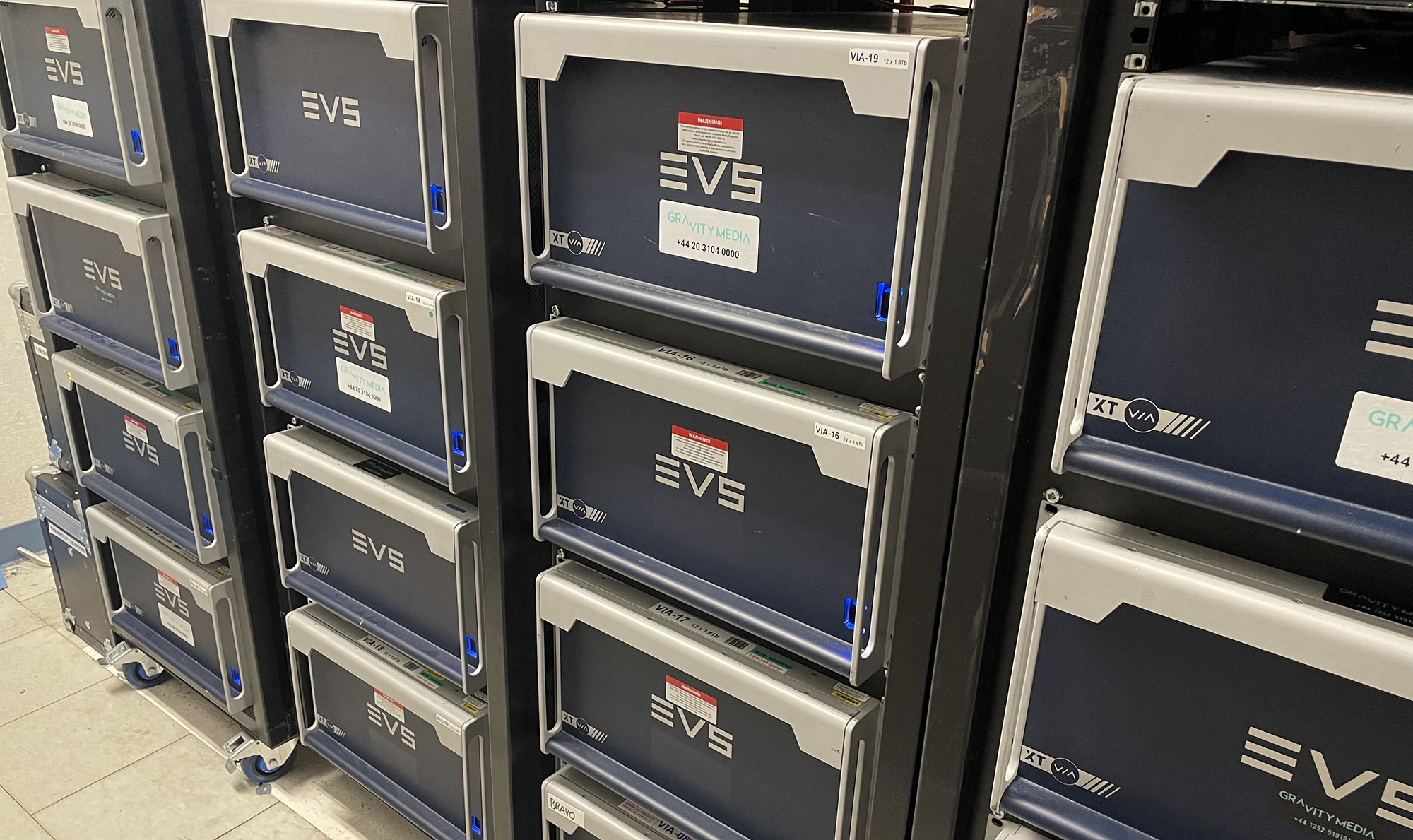Live From US Open 2023: ESPN Boosts Player Access, Tech Tools in Second Year of 1080p Domestic Broadcasts
Arthur Ashe Stadium matches are back in UHD, with Dolby Atmos audio added
Story Highlights
Since taking over full control of both the host feed and the domestic feed for the US Open in 2015, ESPN has worked with the USTA to augment the technology toolset with each passing year. After a monumental leap forward in 2022 with the implementation of 4K UHD at Arthur Ashe Stadium and 1080p broadcasts standard across all courts, this year’s efforts are centered on refining those workflows even further.

From left: ESPN’s Larry Wilson, senior manager; Stephen Raymond, senior specialist; Brian Sanders, senior remote traffic operations coordinator; Eric Grossman, operations producer; Joa O’Connor, senior operations producer; Traci Flohr, senior operations producer; and Sam Olsen, senior specialist
“It’s a testament to the support that we get from the USTA and [facilities provider] Gravity Media, as well as the planning of the ESPN operations team, that these [1080p and UHD] systems came together last year,” says Larry Wilson, associate director, remote production operations, ESPN. “We’re continuing to [enhance] them this year. The US Open continues to increase in size and scale every single year, and we’re thrilled to be able to support that and bring it to fans.”
To level-up the 1080p workflow this year, all EVS replay servers for both host and domestic feeds have been upgraded to EVS XT-VIA live-production servers, and a new high-speed file-transfer system has been established to accommodate the flood of content running between the Flushing Meadows venue in Queens, NY, and ESPN facilities in Bristol, CT, over the two-week tournament.
At Ashe, Dolby Atmos sound has joined the party. In addition to UHD for the host feed, all Ashe Stadium matches are also being produced with enhanced 5.1.4 surround audio. Although ESPN does not distribute them domestically in UHD or Atmos, the host feed is provided to USTA, which supplies it to interested rightsholders (including DirecTV in the U.S.).
1080p Takes the Next Step: XT-VIAs, File Transfer to Bristol, Graphics Effects
Gravity Media, which handles all technical integration for ESPN’s “double stack” production facility at the USTA Billie Jean King Tennis Center, upgraded the massive EVS ecosystem to XT-VIA live-production servers alongside associated upgrades to the XHub-VIA and Xsquare-VIA suite of tools. The full EVS VIA server and infrastructure comprise more than 30 servers, as well as 15+ XTAs and 20+ IPDirectors.
“Having VIAs across the board provides us with more 1080p input channels and allows us to maintain the quantity of phases we need on our super-slow cameras in 1080p,” says Sam Olsen, senior remote operations specialist, ESPN. “It also allowed us to connect our XHub-VIA network directly to NEP’s Supershooter 9, [which is] supporting our dual-network and DirecTV productions so that we’re all looking at the same XNet network. That wasn’t the case last year, so it has been a nice upgrade.”
To accommodate 1080p, ESPN also had to bulk up its file-transfer backbone between Queens and Bristol. This year, ESPN enlarged its transfer-system storage unit and moved from spinning disc to solid-state-drive infrastructure to increase speed and robustness. ESPN now has a 2-Gbps file-transfer pipe incorporating Signiant workflows, hot folders, and priority traffic lanes to ensure as much efficiency as possible.
“The main reason for rebuilding it was the move to 1080p since we were already pretty much filling the pipe with 1080i; it was essentially a mandatory refresh for us,” says ESPN Senior Technical Specialist Steve Raymond. “It was a win-win-win situation: it’s at an affordable price, provides better speed and bandwidth, and is a lot smaller and lighter than spinning-disc arrays we’ve used in the past.”
ESPN also commissioned a new custom-built 1080p on-air–effects system to replace an aging Orad graphics system that was still serving a primary role in its broadcasts.
“The Orad box was 10 years old and hadn’t been supported for several years,” notes Raymond. “We reached a point where we had to refresh that. We decided to contract some very talented individuals to rebuild the whole concept from scratch using off-the-shelf computer hardware.”
According to Raymond, ESPN hunted for a low-latency solution from established broadcast-equipment manufacturers but couldn’t find a system offering anything less than eight frames of latency. So ESPN enlisted a small group of specialists to create custom application software and hardware using off-the-shelf technology. The resulting system has just two frames of latency.
“Having only two frames [of latency] allows us to make that transition from the effect to the live court without having any jump cuts or other on-air issues,” he says. “It takes in 16 inputs, and it’s tied to the switcher so it knows what your transitions are going to be ahead of time through presets and generates a whole different set of graphic packages for our various needs.”
All the Simplylive ACES automated court-production systems for outer-court coverage were upgraded to 1080p last year, and NEP Fletcher continues to improve them. In addition to refining the algorithms used to automatically produce match coverage on the courts, several ACES systems are now using 20X lenses for the primary camera instead of 14X lenses.
“That obviously gives a more intimate perspective to the viewer,” says Wilson. “There was actually a SportsCenter Top 10 play at No. 1 from one of the ACES courts [in Week 1] — it showed a player hitting the ball through his legs — using one of those 20X lenses. That shows you how much of an improvement [it offers].”
Closer to the Action: ‘Towel Cams’ and Practice-Court Interviews Bring Fans Courtside
ESPN and the USTA have worked closely this year to provide viewers more access to players than ever before.
At Wimbledon this summer, ESPN began miking players during practice sessions so that they could share their perspective on their training and performance directly with fans. That on-air element has made its way to the US Open, with multiple players — including American sensation Ben Shelton — taking part. ESPN is using Riedel Bolero wireless intercom systems and wireless mics to conduct the live interviews.
 A Sennheiser Presence earpiece is being used for on-court interviews, here with Ben Shelton, during practice sessions.In addition, after introducing the “towel cam” last year, ESPN has brought it back to Ashe and added a third unit this year. ATOM one mini 1080p PTZ cameras are affixed to the player’s towel bin, offering up-close views of the player’s face between points.
A Sennheiser Presence earpiece is being used for on-court interviews, here with Ben Shelton, during practice sessions.In addition, after introducing the “towel cam” last year, ESPN has brought it back to Ashe and added a third unit this year. ATOM one mini 1080p PTZ cameras are affixed to the player’s towel bin, offering up-close views of the player’s face between points.
Other key cameras this year include Spidercam wired aerial systems on both Ashe and Armstrong Stadiums, a SupraCam two-point aerial system covering the grounds, NetCams across the three largest courts, 11 robos for court coverage, 32 specialty cams positioned around the grounds and on the courts, and multiple RF gimbal cameras and 10 standard RF cameras traversing the Tennis Center.
“We’ve certainly added more this year in terms of access,” says Olsen. “Production is always looking to get closer and add more behind-the-scenes [coverage]. We’ve changed out a few locations to dip further into the actual experience of the crowd and the players here.”
ESPN’s onsite studio coverage is once again playing a key role in bringing the ambiance of the venue to the viewer at home. In addition to its long-established set locations at the practice courts, the ESPN and ESPN International sets at the South Plaza Fountains, and the Chase Lounge set, the network has added a new spot at the Chase Terrace atop the Grandstand roof.
Inside the ‘Double Stack’: A Technological Beast of a Broadcast Facility
Each year, ESPN’s production team asks for more cameras and audio sources that would have sent the engineering team scrambling in past eras. However, since the facility is fully IP-based, ESPN now has the headroom and flexibility to scale up as required.
ESPN’s IP-based host-broadcast facility is built around a Cisco Nexus 9508 core switcher, with two Nexus 9236C units serving as leaf switches in the TOC and a Lawo VSM IP control system. Grass Valley IQUCP25 gateways installed at the IP core provide bridges to the rest of the facility. The Grass Valley Kahuna production switchers (with Maverick panels) and Grass Valley MV-821 multiviewers assigned to the seven production-control rooms at the facility are IP-native as well.
“Since we took over this project, no two years have been the same,” says John Williams, director, media services and facilities, Gravity Media. “We’ve evolved from a 1080i baseband production to a 1080p IP solution, with Ashe now UHD as well. Every year, part of our huge inventory gets a refresh, and we bring this to the US Open. If it’s new, it’s here.”
Getting everything rigged and ready for the first day’s play required a full Gravity Media crew of more than 150 to arrive onsite in early August.
“Working with the ESPN and the USTA is always a pleasure,” he adds. “They are fantastic partners, and we are a great team juggling whatever the tournament can throw at us.”
Olsen adds, “The US Open gets bigger every single year, and Gravity Media Group are the primary providers of services to make that all happen. Once again, they’ve delivered to a very high level and done an excellent job.”
Among other key broadcast vendors are Filmwerks, providing power for all the facilities onsite; The Switch, ESPN’s primary transmission provider (ESPN has a whopping 40 transmission paths going out and another dozen return paths); and SMT, supplying a wealth of data feeds to drive the broadcast.
Logistical Labyrinth: Crewing ESPN’s Biggest Remote of the Year
The US Open is ESPN’s largest and longest annual onsite remote operation, with 957 main-draw and qualifying matches over the course of 18 days (totaling 260 hours of coverage on ABC, ESPN, ESPN2, and ESPN Deportes and more than 550 main-draw matches on ESPN+ and ESPN3). Although the technical complexities of the US Open are extremely daunting, the crewing and logistics are equally formidable.

ESPN’s 18-day marathon in Flushing Meadows was actually extended to 19 days this year because of weather complications during the qualifying rounds.
“It’s a very challenging time right now in terms of crewing any event,” says ESPN Senior Operations Producer Joa O’Connor. “This is our biggest all year, and we start thinking about next year the day after this event ends. From a crewing perspective, all we can do is try to be ahead of it and try to anticipate where we might need more or less support. Considering that we have an 11:00 a.m. start and don’t typically wrap until after midnight, we do our best to manage people and avoid too much overkill. We also are doing everything we can to bring younger and more diverse people into this industry, and that’s very exciting to me personally.”
This year’s US Open marathon will actually total 19 days because of weather issues that extended play during qualifying rounds. To complete all the necessary qualifying matches, ESPN and the USTA were able to scramble to get additional courts up and running for broadcast ahead of schedule. This included additional ACES courts and Court 17 on Thursday and Friday, as well as at Armstrong for one day.
“We’re happy to support the USTA and very glad that we were able to accommodate them so that they could get their play in,” says Wilson. “It was a very wild few days, and then we had the main draw immediately after. I couldn’t be prouder of this entire team for pulling all of this off.”






